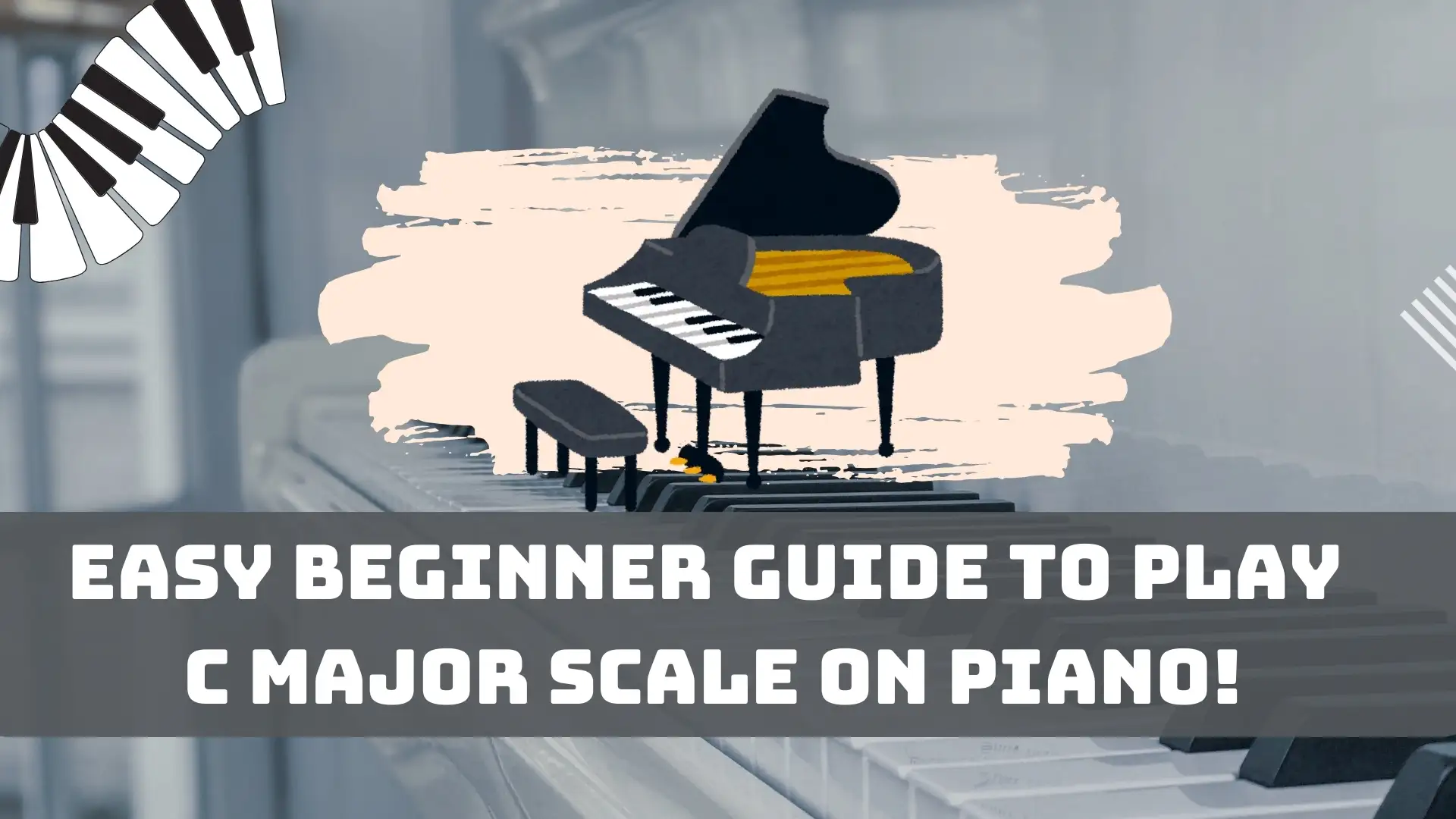- Introduction to Music Scale
- Surprising Benefits of Learning Scales!
- How is the C Major Scale on Piano Formed?
- C Major Scale Piano Notes
- C Major Scale Piano Finger Position
- C Major Scale on Piano Using Right Hand
- C Major Scale on Piano Using Left Hand
- Degrees of the C Major Scale
- C Major in Pop and Classical Music
The C Major Scale on Piano is the fundamental building block for playing piano. Whether you are a beginner or an advanced pianist, understanding and mastering these scales will enrich your musical journey. In this blog you will get to know how this scale is formed and C major scale piano finger position along with songs that made using C major.
So, let’s take this harmonious journey together!
Introduction to Music Scale
Before get into c major scale on piano , First it is important to understand what is music scale is? It is a set of predefined notes played either in ascending or descending order, following a specific pattern of timing or intervals. Scales provide the basis for melody, harmony and chords in music. They are important tools for understanding music theory, improvisation, and composition. Practicing scales allow pianists to have a better understanding of the piano & keyboard, allowing them to explore parts and melodies effortlessly.
Surprising Benefits of Learning Scales!
This offers many benefits for musicians of all levels and instruments. Take a look at some of the major advantages of learning music scale.
- Finger skills and technique: Using scales helps develop finger strength, flexibility and coordination. With regular exercise you will flex your fingers more effectively, allowing you to play more complex music with ease.
- Improved instrumental memory and skills: Memorizing and practicing scales gives you a better understanding of the structure of an instrument, such as the keyboard of a piano or the fret board of a guitar. This knowledge is critical for quick and accurate guidance during operations.
- Ear training: Playing scales improves your ear’s ability to recognize intervals, shapes and pitches. This enhanced ear training allows you to play by ear, copy music and work with greater confidence.
- Understanding music theory: Scales and the foundations of music theory. Learning scales give you insight into composition, harmony and rhythm, allowing you to analyse and understand music at a deeper level.
- Chord progression and improvisation: Scales form the basis for chord progression and improvisation in various genres. Understanding the scale allows you to create melodies, riffs, and solos that perfectly match a given song.
- Speed and accuracy: Practicing with scales on a regular basis can greatly improve your speed and accuracy while playing. As your muscle memory builds, your fingers will automatically know where to go, making you more efficient and accurate.
- Building music: Many songs, especially in classical and jazz music, incorporate scales. Once you are familiar with the scale, it will be easier to identify and interpret these verses, and expand your verses.
- Confidence and Professionalism: As your technical skills improve through scale practice, you will gain confidence in your abilities. This confidence translates into better performances and a more enjoyable musical experience for both you and the audience.
- Movement: Understanding the scale allows you to move songs to different keys. Transposing is a valuable skill for adapting music to different instruments or voices.
How is the C Major Scale on Piano Formed?
In music, “major” refers to a specific musical scale or the key that has a bright, pleasing, positive sound. The major scale is one of the basic building blocks in Western music and is commonly used in music genres including classical, pop, rock, jazz, and more.
The C Major Scale on piano is a good place to start because it has all the natural tones (all white keys, no sharps or flats – black keys). It follows the sequence of whole steps, also known as ‘tone’. It involves moving from one note to another by skipping one key in between.
For example, from C to D, or from F# to G#, and half steps, also known as ‘semitone’, it consists of moving from one key to the very next key, regardless of its colour (black or white). For example, from C to C#, or from E♭ to E, which, when played correctly, produces a delightful, joyful sound.
C Major Scale Piano Notes
C – D – E – F – G – A – B – C
The pattern of whole (W) and half (H) steps in the C Major Scale notes will make it easier to understand how the scale is formed and is as shown below:
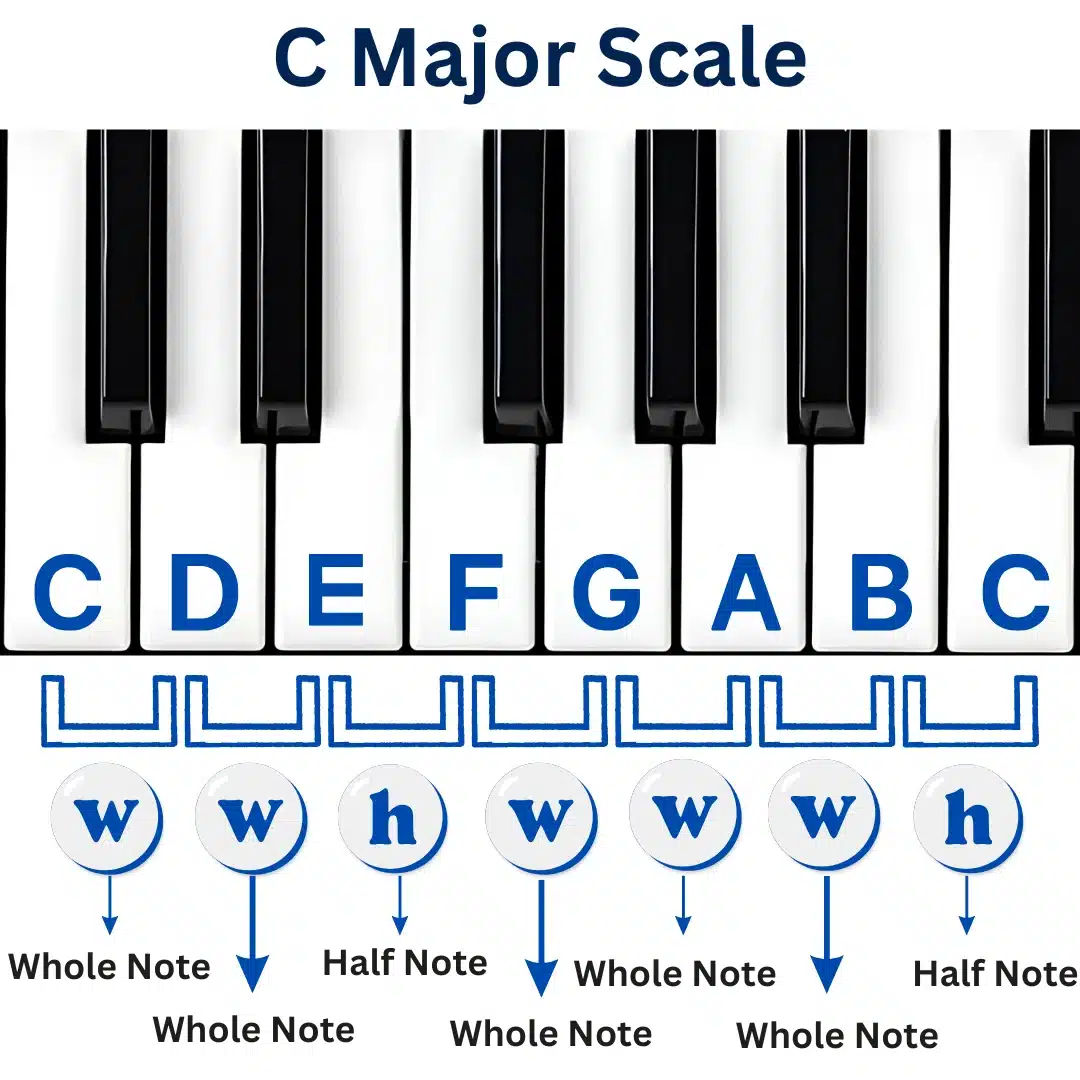
C Major Scale Piano Finger Position
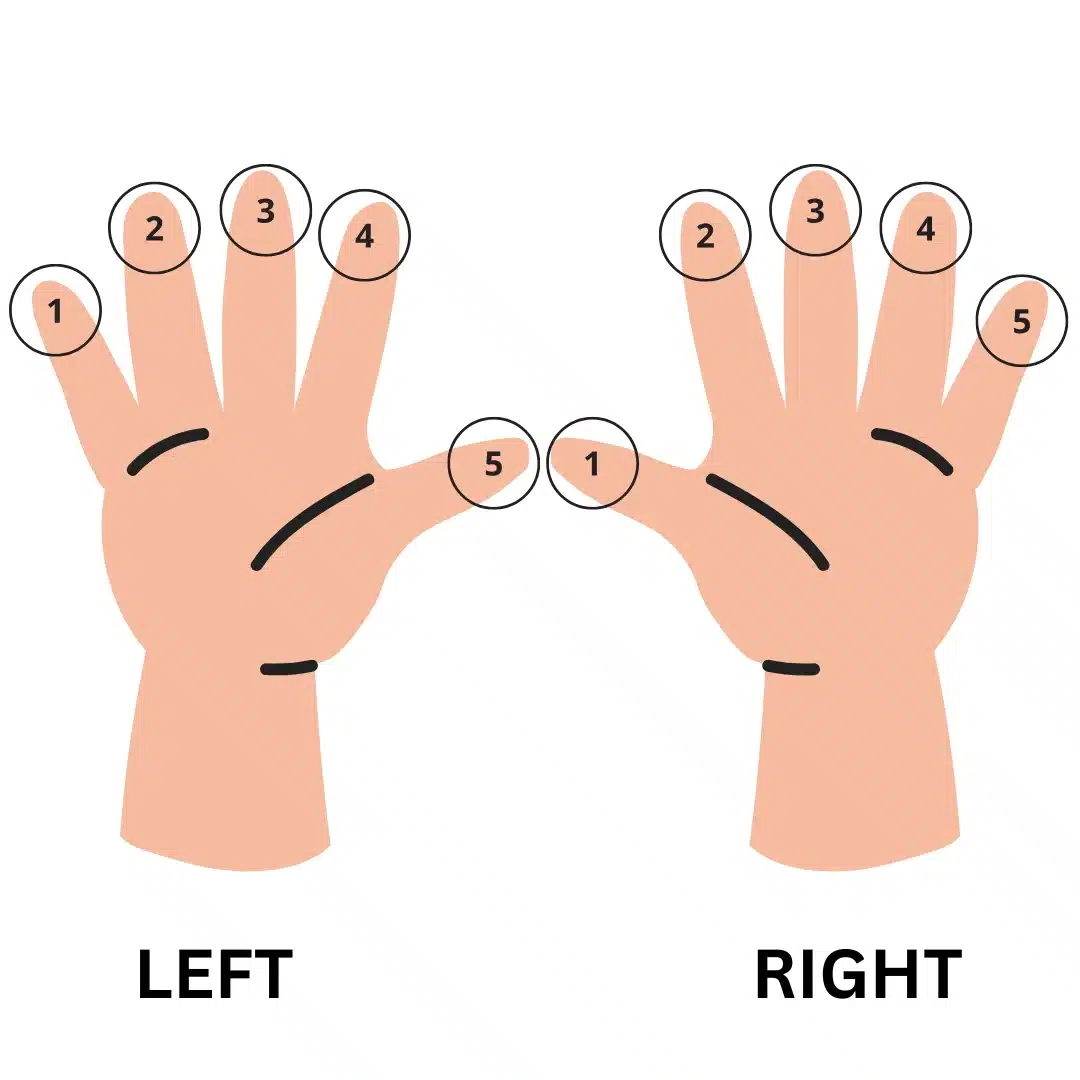
C Major Scale on Piano Using Right Hand
Playing the C Major scale piano note with the right hand involves using the following finger numbers:
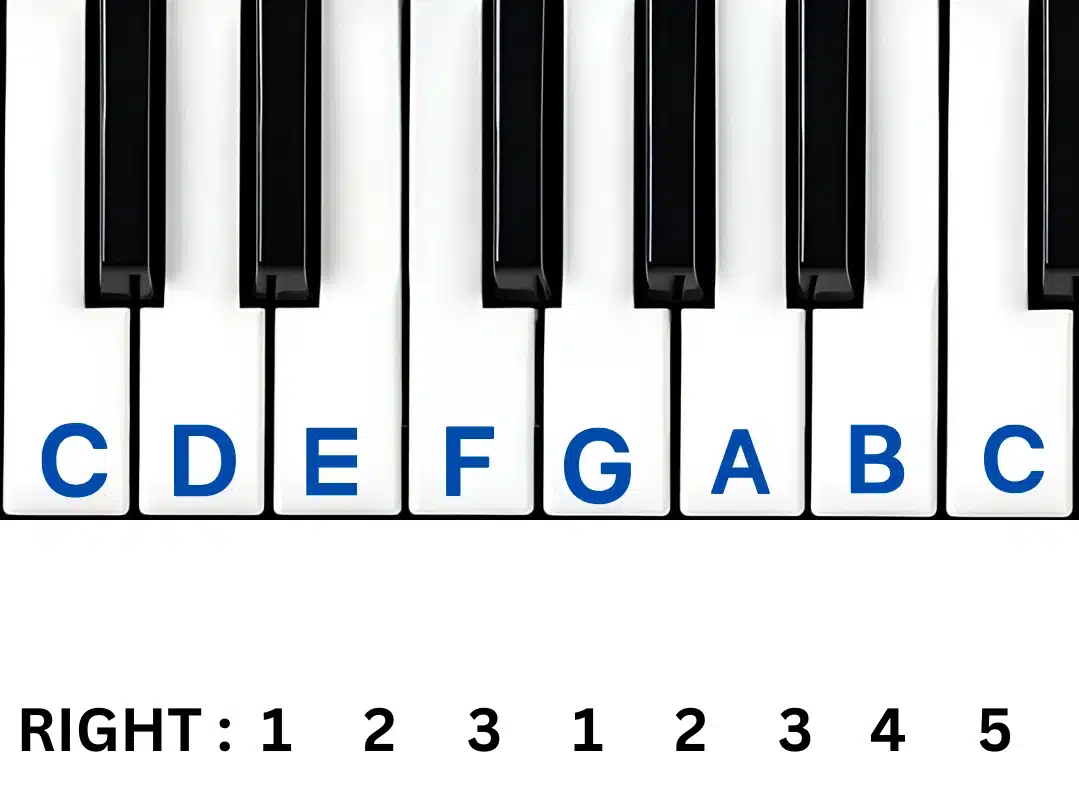
Ascending: (1) – C (2) – D (3) – E (1) – F (2) – G (3) – A (4) – B (5) – C {octave higher}
Descending: (5) – C {octave higher} (4) – B (3) – A (2) – G (1) – F (3) – E (2) – D (1) – C
For an extra challenge, you can extend the major scale to more than 1 octave. Instead of playing the C (octave higher) with finger 5, cross down finger 1 on this C and repeat the finger numbers mentioned above. On the very last C (ascending) use finger 5 and descend with the above mentioned finger numbers.
C Major Scale on Piano Using Left Hand
Playing the C Major scale with the left hand involves using the following finger numbers:
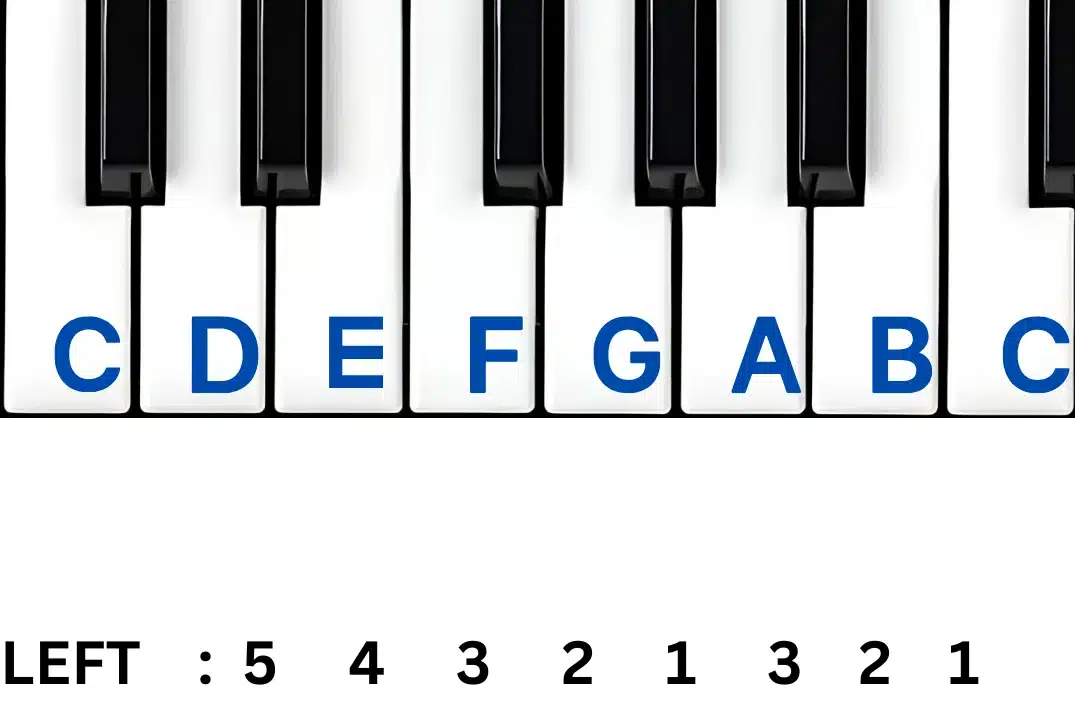
Ascending: (5) – C (4) – D (3) – E (2) – F (1) – G (3) – A (2) – B (1) – C {octave higher}
Descending: (1) – C {octave higher} (2) – B (3) – A (1) – G (2) – F (3) – E (4) – D (5) – C
Additionally, you can extend the major scale to more than 1 octave in the left hand, simple repeat the finger numbers for ascending as mentioned above from D.
Reasons why you should avoid repeating the last note in a scale:
- Fingering: Proper fingering is essential for smooth and smooth operation of the scale. By not repeating the last note, you maintain a consistent fingering pattern and avoid awkward fingering changes, making it easier to play the scale with speed and accuracy.
- Fluid Hand Movement: Avoiding the repetition of the last syllable allows for more fluid hand movements. Your hands can transition smoothly to the next note or measure without unnecessary pauses or interruptions in the movement.
- Rhythm and timing: Repeating the last note can disrupt the natural rhythm and timing of the scale, making it sound wrong or rushed. Playing the scales with a clear, consistent rhythm contributes to a more beautiful performance.
Degrees of the C Major Scale
In music theory, the degrees of a scale refer to the different notes of the scale and their relationships to the tonic (the first note of the scale). The degrees are represented by Roman numerals and are essential for understanding chord progressions, harmonic analysis, and composing music.
Here are the degrees of the C Major Scale, along with their corresponding names:
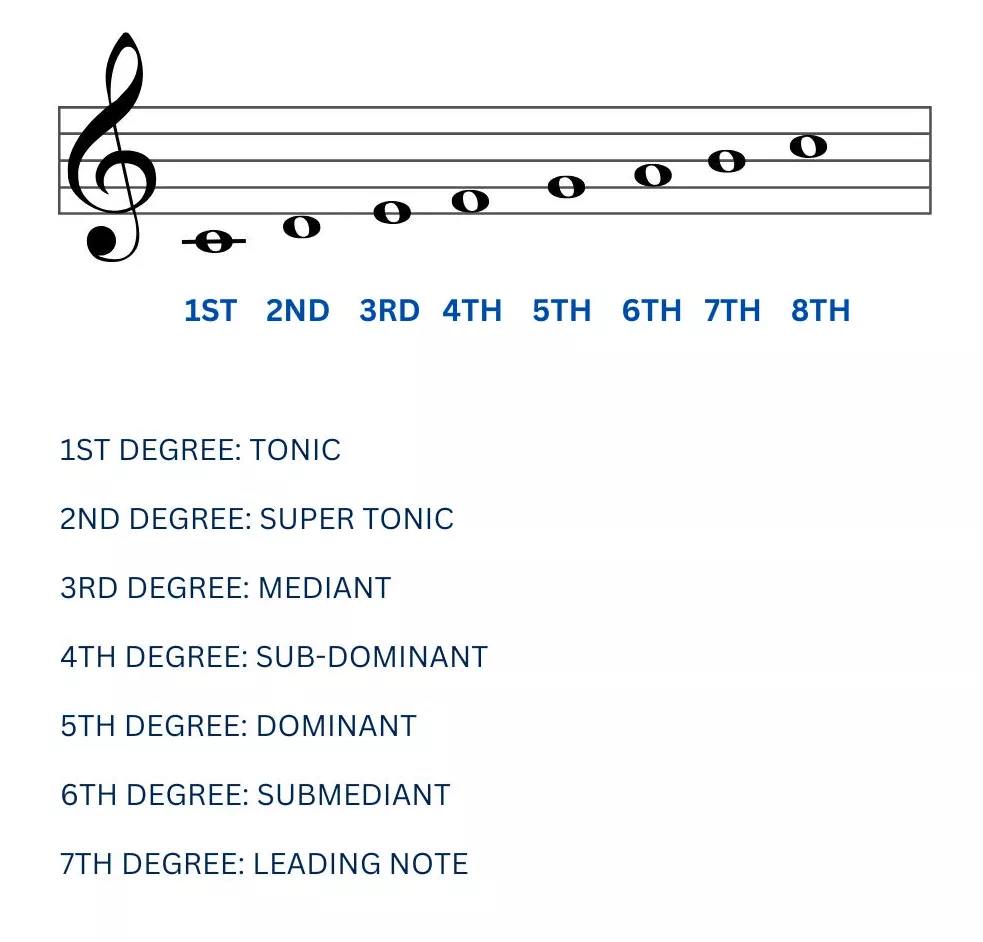
I – Tonic (C): The first note of the C Major scale is the tonic. It’s a home position, leaving you with a sense of musical resolution and stability.
II – Supertonic (D): The second note on the scale is supertonic. It is one step above the tonic and has a slow, incorrigible quality, and usually has tonics or other harmonies.
III – Mediant (E): The third point in the scale is mediant. It lies between the tonic and the dominant (the fifth note of the scale). The interlude adds expression and emotion to the music.
IV – Subdominant (F): The fourth division of the scale is the subdominant. Located below the dominant, it causes a sense of tension, which tends to resolve back toward the tonic or toward the dominant.
V – Dominant (G): The fifth note of the scale is the dominant. It has a strong, powerful quality and tends to create a sense of tension that naturally resolves back to the tonic.
VI – Submediant (A): The sixth note of the scale is the submediant. It is the mirror image of the mediant, residing halfway between the tonic and the subdominant.
VII – Leading Tone (B): The seventh note of the scale is the leading tone. It is just one half step below the tonic and has a compelling tendency to resolve upward to the tonic.
Understanding degrees of a scale makes it possible to understand the harmonic relationships and progression of a piece. Harmonic analysis basically involves the analysis of chords and their relationships in a piece of music. It helps us understand the rhythm and harmony of the composition as a whole. By analysing harmony, we can gain deeper insights into the composer’s mood, emotional content, and overall composition.
C Major in Pop and Classical Music
C major scale piano notes is one of the most common and popular keys used in music, including many hit pop songs. Take a look at some famous pop songs that are written in C major scale piano chords
- “All of Me” – John Legend
- “Someone Like You” – Adele
- “Stay With Me” – Sam Smith
- “Firework” – Katy Perry
- “Can’t Stop the Feeling!” – Justin Timberlake
- “A Thousand Years” – Christina Perri
- “Just the Way You Are” – Bruno Mars
- “Counting Stars” – OneRepublic
- “Shape of You” – Ed Sheeran
- “Roar” – Katy Perry
- “Perfect” – Ed Sheeran
- “Viva La Vida” – Coldplay
- “Let It Go” – Idina Menzel (from Disney’s Frozen)
- “Love Story” – Taylor Swift
Furthermore, keep in mind that some songs may use additional chords outside of the key of C Major for variety and musical interest, although the main key of the song is C Major. Different versions or covers of the song can be in different keys, double checking they key is always a good idea before singing or playing a particular song.
Go ahead and also explore famous classical compositions in C Major scale piano:
- Ludwig van Beethoven – Piano Sonata No. 21 in C Major, Op. 53 “Waldstein”
- Wolfgang Amadeus Mozart – Piano Sonata No. 16 in C Major, K. 545 “Sonata facile”
- Franz Joseph Haydn – Piano Sonata No. 60 in C Major, Hob. XVI/50
- Franz Schubert – Piano Sonata No. 21 in C Major, D. 840 “Reliquie”
- Sergei Prokofiev – Piano Sonata No. 3 in A minor/C Major, Op. 28
- Claude Debussy – “Doctor Gradus ad Parnassum” from “Children’s Corner” Suite
- Robert Schumann – “Carnaval,” Op. 9 (contains movements in various keys, including C Major)
- Frédéric Chopin – Polonaise in C Major, Op. 3
These pieces demonstrate the versatility and beauty of the key of C Major in classical piano music. Each piece has a unique style, feel and technical challenge, making it a favourite for pianists and classical music enthusiasts. Whether you are a performer or a listener, these works offer a fascinating journey into the world of classical piano music.
Congratulations to you! You have unlocked the secrets of the C Major Scale. As you develop and master these foundational scales, you will open doors to endless possibilities on the piano. Remember, the key to improvement is consistency, so keep practicing, exploring, and singing. Embrace the joy of performing, and let music be your guide on this unique journey. Looking for more details to learn Piano or keyboard. Explore online classes piano classes with musicmaster.
Happy practicing!


